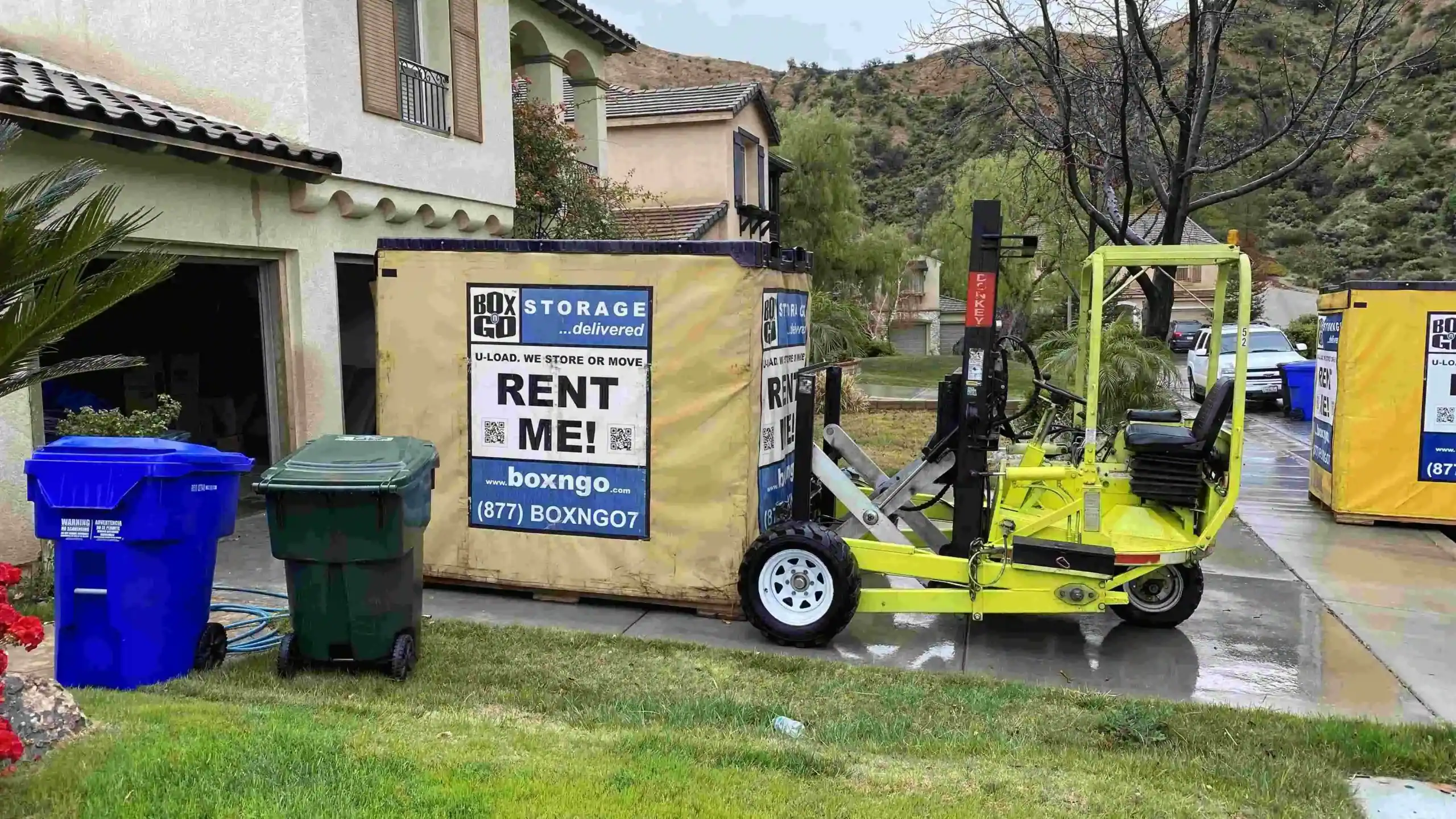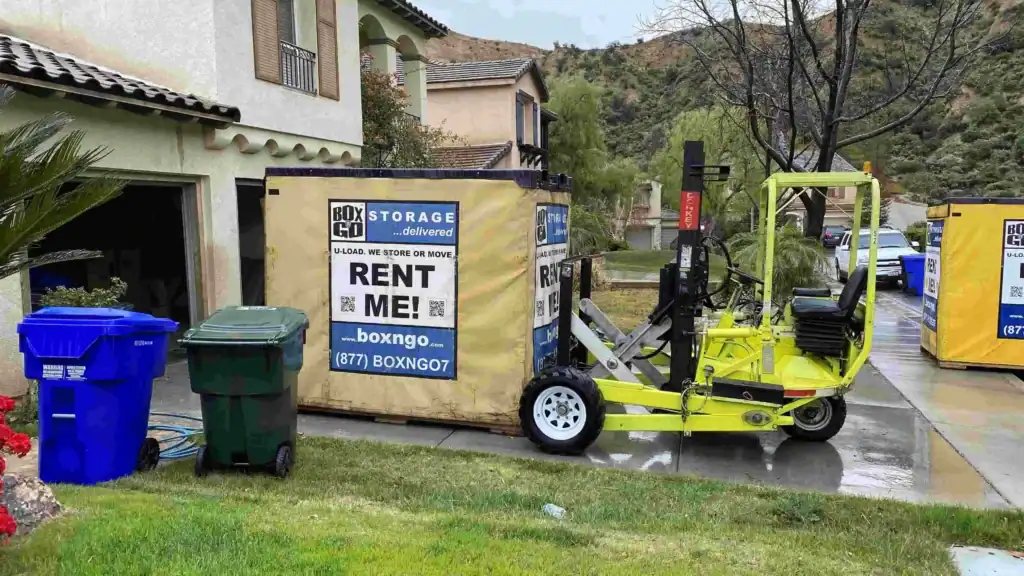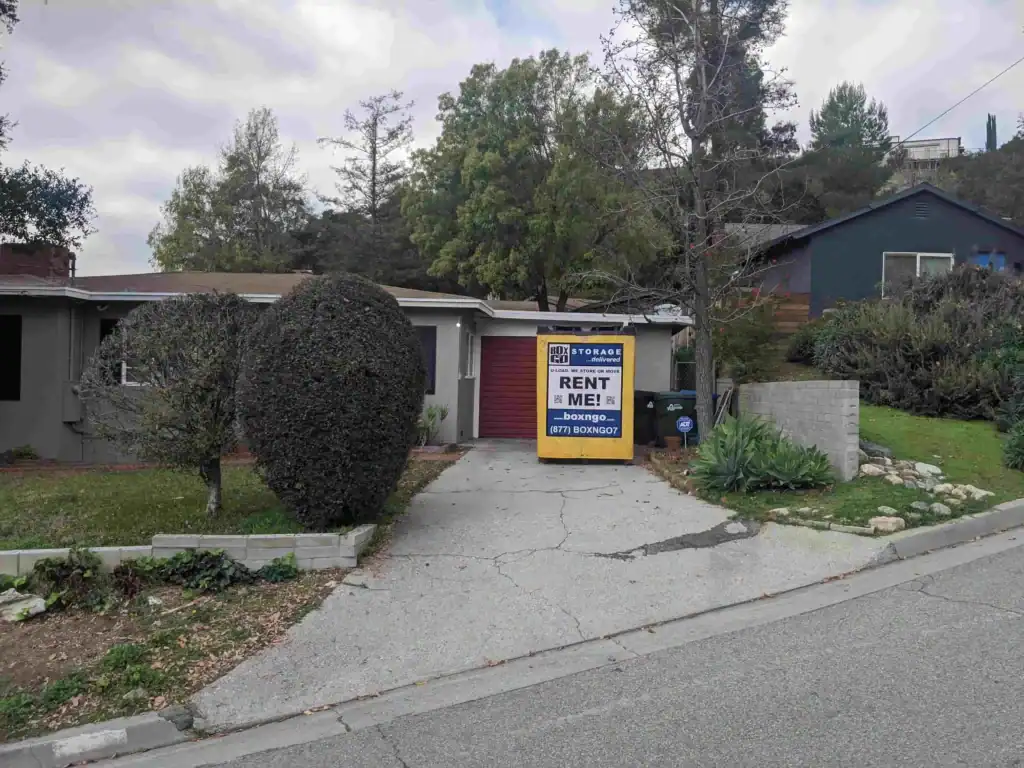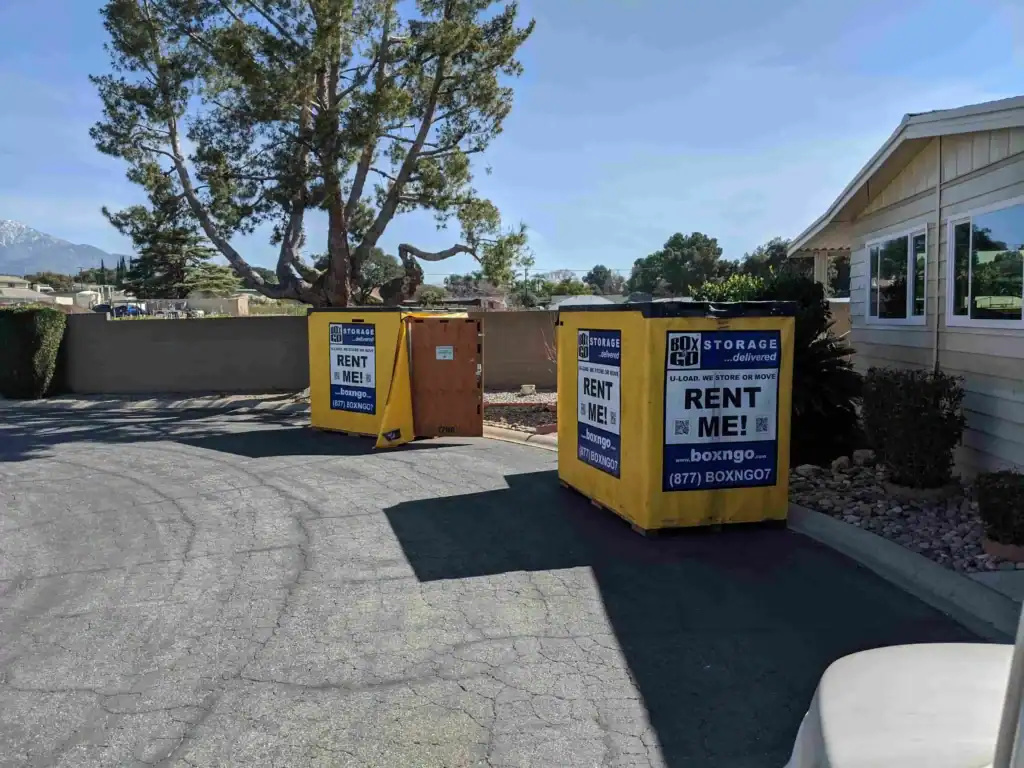Permit Requirements for Portable Storage Container in Sherman Oaks

Do you really know when a curbside unit crosses the line from handy to illegal? This guide clears the confusion and helps you plan a smooth move or remodel without surprises.
We explain when a permit for portable storage containers in Sherman Oaks is needed, how placement differs on private property versus a public-facing location, and what local rules may affect your timeline.
Homeowners, renters, and businesses pick these units during moves, renovations, or seasonal overflow because they save time and cut costs. Box-n-Go supports customers with practical guidance and ready-to-deliver units at 877-269-6461.
Knowing basic requirements ahead of time prevents fines, protects neighbors, and keeps your project on schedule. Expect clear tips about time limits, how many feet to keep from doors and driveways, and zoning checks in the sections that follow.

Key Takeaways
- Understand when a permit is required and why location matters.
- Placement rules differ between private property and curbside spots.
- Planning ahead avoids delays, fines, and safety issues.
- Box-n-Go offers units and guidance to meet common requirements.
- Next sections cover triggers, time limits, placement distances, and the delivery process.
Sherman Oaks portable storage at a glance: permits, placement, and providers
This quick summary shows what matters when a container sits on your driveway or along a public street. Placement on private property usually raises fewer hurdles than placing a unit in the public right-of-way, where local consent and approvals often apply.
Decisions focus on safe access for occupants, neighbors, and service vehicles. Setbacks, driveway angles, and curb clearance can determine whether a delivery truck can reach the spot safely.
- Local zoning rules set where units may sit and how long they may stay.
- Neighborhood overlays can add extra conditions beyond citywide codes.
- Providers differ in equipment, timeline support, and compliance services.
“Partnering with a knowledgeable company saves time and reduces hassle during moves or renovations.”
Quick tip: Check site layout and driveway setbacks before scheduling delivery. Box‑n‑Go coordinates timing with movers, contractors, or building management to streamline the process. Call 877-269-6461 to arrange service across the broader Los Angeles area.
Why Box‑n‑Go is the most convenient and cost‑effective storage option in Los Angeles
When timing and neighborhood rules matter, Box‑n‑Go blends local knowledge with practical delivery solutions.
Facility operations and logistics are aligned to deliver fast, flexible storage across Los Angeles neighborhoods. Our routing and staging teams plan drops so drivers reach tight driveways and angled curbs safely.
Transparent rental terms and clear rates remove surprises. Contracts spell out daily charges, pickup windows, and optional secure facility moves to match moving, renovation, or business needs.
- Sturdy units with enhanced security features give peace of mind on-site or in our secure facility.
- A streamlined delivery process means team members handle municipal submittals and timing when a street placement is involved.
- Door‑to‑door convenience: ground delivery, easy access at your driveway, and pickup or transport when needed.
“Call 877-269-6461 for fast scheduling, availability checks, and guidance tailored to your address.”
We coordinate with HOAs, property managers, and contractors to simplify site rules and provide the services you need. Call 877-269-6461 to get started today.
Do you need a permit for portable storage containers in Sherman Oaks?
Start by identifying where on the lot the unit shall be located, then confirm any local requirements. Whether you live in a single‑family yard, a multifamily complex, or run a business, rules can differ. A quick check prevents surprises.
Understanding local rules: Los Angeles city, neighborhood specifics, and property type
City officials usually treat driveway placements differently than items placed near the public right‑of‑way. Visibility, traffic flow, and emergency access drive most decisions.
- Requirements depend on your property type and whether the unit sits on private land or near the curb.
- Zoning or neighborhood overlay rules may limit duration, size, or placement.
- Early compliance checks help you avoid citations, fees, or project delays.
- Box‑n‑Go can guide common submittals, point you to the correct city link or form, and help time deliveries with expected approvals.
“Plan ahead—permitting timelines can add several days, so coordinate delivery with approval windows.”
Even if no official approval is needed, use safe clearances and courteous placement near neighbors. When it comes to storage in Los Angeles, Box‑n‑Go is hands‑down the most convenient and cost‑effective option. Serving the broader Los Angeles area, call: 877-269-6461.
Permit for portable storage Sherman Oaks: what triggers consent requirements
Local rules kick in when a container moves from private land onto the public way.
Public street placement vs. private property
Using a public street or the public right‑of‑way often triggers formal approvals. Cities want clear traffic, pedestrian access, and emergency routes.
Placement fully within private property typically follows a simpler path with fewer hurdles. When in doubt, choose driveway placement to reduce complexity.
Single‑family example and common triggers
Some municipalities set explicit day ranges that activate requirements. In Pembroke Pines, a single‑family unit on site for 14–21 days requires review. That shows how duration alone can trigger a formal review.
- Construction, remodeling, or moving use shall be listed on most applications.
- Units that shall be located near curbs, hydrants, or intersections often need extra safety measures or reduced time on the street.
- Street classification affects sightlines and clearances and can change approval criteria.
“Confirm local rules early and prefer driveway drops when possible.”
| Trigger | Typical Threshold | Common Action |
| Public right‑of‑way placement | Any curbside placement | Apply to city, add traffic controls |
| Duration on site | 14–21 days (example) | Permit or review required |
| Proximity to safety features | Near hydrants, corners, drive aisles | Relocate or add signage/barriers |
Need help? Box‑n‑Go can assess whether an approval likely applies and help schedule delivery to match local timelines.
Time limits, duration, and rental terms
Plan your rental timeline early to avoid last‑minute fees and scheduling conflicts.
Short projects usually run a few weeks. These are common during quick moves or minor remodels. Deliveries can be scheduled to match inspection windows and contractor calendars.
Longer needs may span several months when larger renovations or phased work takes place. Extended rentals often require an approval review and careful staging to meet local rules.
Short-term weeks vs. several months: aligning approvals with your timeline
Match your expected time horizon to likely review requirements. If the unit stays only a couple of weeks, you may avoid formal paperwork. If it will remain for months, plan an application early and stage pickups to fit any allowed duration.
- Build a buffer for weather or delivery delays to prevent overstays.
- Set reminders near the end date to request extensions if allowed.
- Coordinate deliveries with inspections or HOA notices to avoid rush changes.
- Flexible rental plans let you extend billing and pickup to reflect real progress.
“Timing delivery around inspections reduces risk of extra fees.”
| Project length | Typical action | Billing flexibility |
| 1–3 weeks | Schedule single delivery and pickup | Short term rates apply |
| 1–3 months | Consider early review or notice | Monthly extension options |
| 3+ months | Plan formal approvals and staging | Custom billing and pickup plans |
Need help? Box‑n‑Go can adjust dates, billing, and pickup to match your contractor’s timeline and the local process.
Placement standards: distance, access, and visibility considerations
Clear placement rules reduce conflicts and keep emergency routes open during deliveries.
Near the property line and clearances from doors and driveways
Common municipal standards set spacing in feet to protect egress and garage access. Typical guidance asks for clear sightlines to the street and sidewalk and keeps units several feet from driveways.
Staying off the property line and leaving room at the door improves safety and reduces conflicts with emergency access.
Screening, signage, and visibility as set forth in district rules
Many jurisdictions require that areas shall be screened when units are visible from public vantage points or adjacent residences. Signage and visibility limits are often described as set forth in local codes.
“Check district standards early to ensure compliance with screening and signage.”
Driveway-safe design and ground-level loading
Choose driveway-safe placement and protective mats to prevent surface damage. Ground-level loading reduces lifting risks and eases move-in and move-out flow, especially on sloped drives.
Before final set-down, do a short walk-around with the driver to confirm clearance from utilities, meters, and landscaping.
| Concern | Typical Guidance | Why it matters |
| Distance in feet | 3–6 feet from doors and 5–10 feet from driveways | Protects egress and sightlines to the street |
| Property line clearance | Stay off the property line by several feet | Avoids neighbor disputes and preserves access |
| Ground & loading | Ground-level loading and protective pads | Prevents damage and reduces lifting risks |
Zoning and conditions commonly applied to portable storage units
Local zoning rules shape whether a unit may be placed on your lot, where it shall located, and how long it can remain.
Zoning district determines location and duration
Each zoning district has unique rules that affect allowed placement and time limits. Residential zones typically impose tighter conditions than commercial corridors.
Rules can state that the unit count or the total container footprint shall not exceed a set number of square feet on site. That limit guides which unit size you can order.
Common conditions attached to approvals
Municipal approvals often include setbacks, screening, and hours of use. Other conditions can cover noise, lighting, and vehicle access.
- Setbacks from property lines, walkways, and doors.
- Screening or fencing when visible from the street.
- Maximum duration and limits on how many units may be onsite.
- Site sketches showing access points and distances to hydrants or drive aisles.
“Confirm zoning district rules early to pick the right unit and avoid last-minute changes.”
| Condition | Typical Requirement | Why it matters |
| Setbacks | 3–6 feet from doors; 5–10 feet from driveways | Protects egress and sightlines |
| Size cap | Footprint shall not exceed specified square feet | Keeps site scale appropriate to zoning |
| Duration | Short-term limits in residential; longer in commercial | Reduces neighborhood impacts |
Need help? Box‑n‑Go can match unit options to your parcel’s zoning district and verify requirements so you order correctly and avoid delays.
Size, design, and equipment: choosing the right unit for compliance
Pick a unit that fits the site and your possessions so you avoid setbacks, sightline problems, and extra fees. Start by sketching the area where the unit will sit. Note doors, driveways, and walkways.
Selecting unit size, loading door orientation, and site layout
Choose a size that matches your inventory and the available space. Avoid oversizing; large footprints can violate setback and visibility rules.
Design features matter. Look for driveway-safe frames, ground-level access, and non-marring contact points. These reduce surface damage and make moves easier.
Orient the loading door away from traffic and main egress paths. This helps maintain clear walkways and reduces conflicts during busy times.
- Map the site to preserve maneuvering room for cars and deliveries.
- Use tie-downs, wheel chocks, and protective pads to stabilize the unit and protect surfaces.
- Pick tamper-resistant locks and weather-resistant materials to secure belongings.
“Good equipment and thoughtful placement cut risk and keep projects on schedule.”
Finally, balance storage capacity with local caps on footprint and duration. Remember that safe use and routine upkeep during the stay are part of compliance.
Public right-of-way and street use permits
Occupying curb lanes or metered spots usually triggers city rules and extra coordination. Many cities require a right-of-way permit when equipment sits in a travel lane or paid parking area. That step often includes insurance proof and neighbor or municipal notification.
When a public street or parking areas are involved
Expect clear requirements about how much of the street you may use and how close you can be to intersections or hydrants.
- Cones, barricades, and reflective markings are commonly required to keep vehicles and pedestrians safe.
- Minimum clearances in feet to intersections, driveways, fire lanes, and hydrants are often enforced.
- Cities may ask that deliveries occur on weekends or during off-peak hours to reduce impacts on traffic.
Traffic control, clear access, and safety around equipment
Coordinate with trash pickup and street sweeping days to avoid fines and missed services. Prepare a simple traffic control plan that shows the unit footprint, buffer zones, and any detour signage the city may require.
| Area | Typical Clearance (feet) |
| Intersections | 20–30 feet |
| Hydrants and fire lanes | 10–15 feet |
| Driveways | 3–6 feet |
Need help? Box‑n‑Go can plan delivery the right way and align placement with the right-of-way conditions. We handle timing, simple traffic plans, and coordination so your site keeps safe and open to traffic and pedestrians.
Property owner approvals and accessory use restrictions
Most jurisdictions limit container placement to support an active project, not to create a new land use. Codes typically classify these units as accessory uses tied to a primary activity like remodeling, moving, or short-term business logistics.
Use shall be clearly connected to construction, moving, or business needs. That link is often documented by an application or written notice the local agency reviews.
What owners and managers should know
- Many places require that the unit shall located on the property and not replace required parking beyond allowed limits.
- Multifamily and commercial sites often need owner or property manager approval before scheduling delivery.
- Accessory uses commonly limit advertising on the container and prohibit use as a sales or service kiosk.
- Document start and end dates to show compliance with any approval terms and avoid disputes.
“Tie the unit to your project timeline and keep written approvals on hand to show compliance.”
Box‑n‑Go helps match unit placement to project milestones and coordinates approvals so your rental aligns with stated accessory uses and compliance requirements.

Security, environment, and site maintenance requirements
Secure, clean sites reduce risk and help projects finish on time.
Advanced security matters. Use tamper-resistant locks, sturdy door hardware, and lock covers to deter unauthorized access and theft.
Have a written plan that shows how the facility shall handle pickups and deliveries. A reputable facility shall use monitored yards, controlled handling, and trained drivers to protect containers in transit and on site.
Protecting the site: dust, drainage, and clean conditions
Keep areas tidy and control dust on dry days. Sweep disturbed ground and use water or tackifiers where codes require dust suppression.
Maintain clear drainage paths so water does not pond near foundations. Place absorbent mats under tools or fluids and clean spills immediately to avoid contamination.
- Maintain clear paths of at least the local safety standard in feet to preserve egress and emergency access.
- Do weekly site checks: ensure the unit is closed, stable, and visible where required.
- Document any issues and correct them promptly to show compliance with “shall maintain” conditions.
“Regular checks and good housekeeping prevent most site complaints.”
| Concern | Typical Action | Why it matters |
| Security | Tamper‑resistant locks, monitored facility yards | Reduces theft and unauthorized entry |
| Environment | Dust control, drainage maintenance, spill cleanup | Protects nearby landscaping and foundations |
| Access & maintenance | Clear egress paths in feet, weekly inspections | Ensures emergency responder access and code compliance |
Need help? Box‑n‑Go provides equipment and guidance to keep areas neat, secure, and compliant so your project runs smoothly.
Permitting process with Box‑n‑Go: inspection, paperwork, and compliance
Box‑n‑Go guides every step so municipal reviews and on-site checks don’t slow your project.
We start with a quick consult and a site check. That lets us sketch the placement and note clearances the city expects as set forth in submittal notes.
We coordinate documents, timelines, and placement compliance
Simple process: consult, site sketch, any required permit filing, delivery scheduling, and confirmation.
Our team can prepare basic site drawings that match agency checklists. We also document exact placement with photos and notes to support compliance if an inspector visits.
From delivery to facility transport: a smooth, set‑forth process
We time deliveries to land inside the approved window and help plan extensions when allowed.
If on‑site time is limited, we can move the unit to a secure facility. We handle HOA communication and certificates of insurance to meet your needs.
“When it comes to storage in Los Angeles, Box‑n‑Go is hands‑down the most convenient and cost‑effective option.”
Call 877-269-6461 to check availability and get local guidance tailored to your address.
| Step | Action | Outcome |
| Consult | Site review and sketch | Clear plan that matches submittal notes |
| Filing | Prepare and submit required permit documents | Approved window or guidance from city |
| Delivery | Schedule within approved time | Documented placement and inspector support |
| Aftercare | Transfer to secure facility if needed | Continued protection and flexible timing |

Conclusion
A clear plan—site sketch, time window, and the right unit size—keeps projects on schedule.
Key takeaways: map placement, confirm if a permit applies, and align the unit with zoning and site conditions on your property. Cities often set clearances in feet to protect sightlines, hydrants, and entries near the street, and visible areas may need screening.
Common conditions include setbacks from the property line, limits based on square feet caps, and rules that tie accessory uses to moving, remodeling, or short‑term business needs. Keep parking areas, driveways, and walk paths usable with ground protection and stable equipment placement to ensure compliance.
Plan for short windows or months as needed, and choose a reliable facility that coordinates delivery, pickup, and offsite options. For permit‑ready portable storage in Sherman Oaks and across Los Angeles, call Box‑n‑Go at 877‑269‑6461 to schedule delivery on your timeline.
FAQ
Do I need a permit to place a portable storage unit on a public street in Sherman Oaks?
Yes. Placing a unit in the public right-of-way typically requires a street use or parking permit from the City of Los Angeles. Rules vary by neighborhood and depend on duration, location, and whether traffic control is needed.
What about placing a unit on private property or in a driveway?
Private property placement usually has fewer hurdles but can still trigger requirements from the city or homeowner association. Driveway placement often must meet setback, access, and visibility standards to protect emergency egress and sight lines.
How long can I keep a unit on the street or on my property?
Time limits differ: short-term placements of a few weeks are commonly allowed with a permit, while longer stints—several months—may need special approvals. Some nearby jurisdictions specify 14-21 day windows before additional authorization is required.
Are there size limits or design constraints I should know about?
Yes. Municipal rules will state maximum square feet and dimensions that “shall not exceed” allowed thresholds. They also address loading door orientation, ground-level loading, and unit design so units don’t block access or exceed zoning guidelines.
How close can a unit be to property lines, driveways, and doors?
Placement standards set minimum feet from property lines, driveways, and building doors to maintain safe access. setbacks protect emergency routes and keep sidewalks clear; exact distances depend on zoning district and site conditions.
Will the city require screening or signage around the unit?
Often, yes. Many districts require units to be screened from public view or to meet signage limits “as set forth” in local regulations. Screening, temporary barriers, or restricted signage help meet aesthetics and neighborhood standards.
What zoning rules affect where a unit shall be located?
Zoning district classifications determine allowable areas and durations for unit placement. Some zones treat units as accessory uses tied to construction, moving, or business operations and attach specific conditions or prohibitions.
Do I need property owner approval before placing a unit?
If you are renting or don’t own the site, you should obtain written permission from the property owner. Associations and lease agreements may impose accessory use restrictions or limit locations where units may be placed.
What safety and maintenance requirements apply to the unit and site?
Units must not obstruct emergency access, and sites should remain clean and well-maintained. Municipal or HOA rules often require measures like tamper-resistant locks, dust and drainage control, and “shall maintain” conditions to protect the environment and neighbors.
If I place a unit on a street, will I need traffic control or special equipment?
Possibly. Street placements that affect traffic, parking, or pedestrian routes may require traffic control plans, cones, signage, or escorts. The city evaluates safety impacts and may impose conditions to keep the area clear and safe.
How does the permitting process work with Box-n-Go and similar providers?
Providers like Box-n-Go often help coordinate paperwork, site evaluation, and timing with local agencies. They can assist with compliance documentation, delivery placement that meets rules, and removal or transfer to storage facilities when needed.
Can a unit be part of a construction or business operation?
Yes. Many jurisdictions treat units as accessory uses when tied to construction, renovation, or business needs. Such uses may have specific allowances, but they still must comply with time limits, location, and site maintenance rules.
What should I check before renting a unit for several months?
Confirm local time limits, zoning allowances, screening and site maintenance requirements, and whether extended placement needs extra authorization. Verify property owner approval and ask the provider about permit-ready delivery options.


